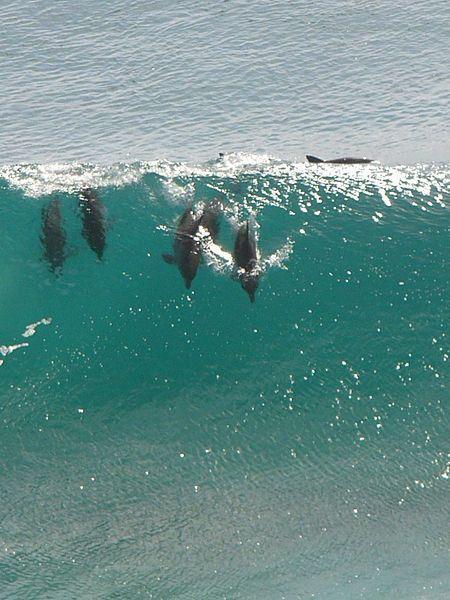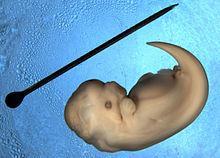 Dolphins surfing at Snapper Rocks, Queensland, Australia
Dolphins surfing at Snapper Rocks, Queensland, Australia
The word “dolphin” is originally from Greek word delphus, which means ”womb”. The animal’s name can therefore be interpreted as meaning “a fish with a womb.”
Indeed, dolphins are not fish but are marine mammals closely related to whales and porpoises – descendants of terrestrial mammals, most likely of the Artiodactyl order. The ancestors of modern-day dolphins entered the water roughly 55 million years ago, in the Eocene epoch. Skeletons of modern dolphins have two small, rod-shaped pelvic bones believed to be vestigial hind limbs.

Most dolphins have acute eyesight, both in and out of the water, and they can hear frequencies 10 times or more above the upper limit of adult human hearing. Dolphins’ hearing is also used for echolocation. Their teeth function as antennae to receive incoming sound and to pinpoint the exact location of an object, as well as the object’s shape and size.
Dolphins can tolerate and recover from extreme injuries such as shark bites although the exact methods used to achieve this are not known. The healing process is rapid and even very deep wounds do not cause dolphins to hemorrhage to death.
Generally, dolphins sleep with only one brain hemisphere in slow-wave sleep at a time, thus maintaining enough consciousness to breathe and to watch for possible predators and other threats.
Dolphins are social, living in pods from a dozen individuals to as many as 1,000 where there’s an abundance of food. Membership in pods is not rigid; interchange is common. They communicate using a variety of clicks, whistle-like sounds and other vocalizations.
Dolphins can establish strong social bonds; they will stay with injured or ill individuals, even helping them to breathe by bringing them to the surface if needed. This altruism does not appear to be limited to their own species. The dolphin Moko in New Zealand has been observed guiding a female Pygmy Sperm Whale and her calf out of shallow water where they had stranded. Dolphins have also been seen protecting human swimmers from sharks by circling around the human or charging the sharks to make them go away.
Dolphins also display culture, something long believed to be unique to humans (and possibly other primate species). In May 2005 in Australia, Indo-Pacific bottlenose dolphins were discovered to teach their young to use tools by covering their snouts with sponges to protect them while foraging. This is a learned behavior transferred by mother dolphins to daughters.
Dolphins are often regarded as one of Earth’s most intelligent animals, which is displayed by the bottle nosed dolphin in the video below.
Finding its pectoral fin bound by a hook and fishing line, but lacking opposable thumbs, the dolphin approached some divers for help. Diving instructor Keller Laros noticed that the dolphin was hanging around them, and that it wasn’t able to move freely. Closer inspection revealed the ocean debris lodged in the fin.
The dolphin not only allowed the divers to attempt to work the line and hook out of the fin, but actually shifted its body to make it easier. The divers were able to remove the fishing line but not the hook.
Alas, contrary to pop culture’s romantic depiction of dolphins, these marine mammals are not all sweetness and light.
Dolphins engage in acts of aggression toward each other, for the same reasons as humans: disputes and competition for females. The older a male dolphin is, the more likely his body is to be covered with bite scars. Acts of aggression can become so intense that the losers sometimes are banished from the pod.
Male bottlenose dolphins also have been known to engage in infanticide. Dolphins have also been known to kill porpoises for reasons which are not fully understood, as porpoises generally do not share the same diet as dolphins and are therefore not competitors for food supplies.
But when it comes to destructiveness, dolphins cannot remotely compete with humans.
Some dolphin species are threatened with extinction, especially in the rivers Amazon in Brazil, Ganges in India, and Yangtze in China. A 2006 survey found no individuals of the Yangtze river dolphin, which now appears to be functionally extinct.
Pesticides, heavy metals, plastics, and other industrial and agricultural pollutants that do not disintegrate rapidly in the environment concentrate in predators such as dolphins. Injuries or deaths due to collisions with boats, especially their propellers, are also common.
Various fishing methods, most notably purse seine fishing for tuna and the use of drift and gill nets, unintentionally kill many dolphins. In some parts of the world, such as Taiji in Japan and the Faroe Islands, dolphins are hunted as food. But since dolphin meat is high in mercury — a poison — humans who eat dolphins will get their just dessert.
H/t FOTM’s Joseph for the video!
~Eowyn

